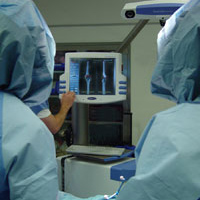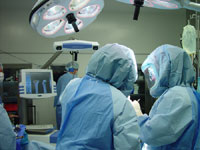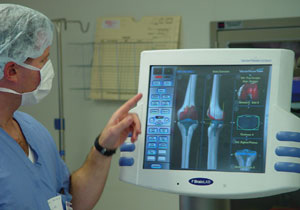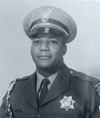Press Release 4.25.2003 – Advanced Joint Replacement Surgery

Northern California Surgeons Pioneer Computer-Assisted, Minimally Invasive Total Knee Replacement Surgery
Shasta Orthopaedics & Sports Medicine surgeons, in concert with medical device company Smith & Nephew, perform world’s first procedure to combine key technologies to enhance the future of joint replacement surgery.
Redding, Calif. – Shasta Orthopaedics & Sports Medicine successfully completed the world’s first minimally invasive total knee replacement surgery enhanced by high-precision, computer-guided navigation on April 16, 2003, the medical office today announced.
The procedure was performed by Dr. John Lange and Dr. Paul Schwartz of Shasta Orthopaedics & Sports Medicine in Redding, Calif. The surgery shows that computer-guided surgical navigation in orthopaedics can provide highly accurate implant alignment and real-time vision of the surgical site through an incision 60-percent shorter than that of traditional total knee replacement with less trauma to underlying muscle and soft tissues.
The goal of high-precision alignment is to help extend the long-term survival of the implanted artificial knee through exact alignment of the implanted prosthesis.
Minimally invasive surgery’s objective is to combine a substantially shorter incision with less trauma to underlying muscle and soft tissues to result in a smaller scar, less post-operative pain and a faster return to physical activity.
Using Smith & Nephew’s minimally invasive surgical instruments and joint replacement software application, the California surgeons have achieved a technological convergence that previews the future of joint replacement surgery.
“We have taken a huge step towards the future of knee replacement surgery,” says Dr. Schwartz. “Being the first surgeons worldwide to combine minimally-invasive total knee replacement surgery with computer-guided navigation in a single procedure is truly remarkable. It’s hard to imagine the scope of the impact this technique will have on the future of orthopaedic surgery.”
“As surgeons, we have always wanted a longer-lasting, less invasive knee replacement procedure,” says Dr. Lange. “This technique moves us closer to the day when a patient can return to physical activity soon after surgery and the day the knee implant will last for the rest of the patient’s life.”
 Each year, 250,000 people in the United States and 600,000 people globally undergo total knee replacement surgery. During the procedure, the surgeon removes the top portion of the tibia and the lower portion of the femur, replacing the bone and cartilage with a metal and plastic device that simulates the natural hinge of the human knee. Using special mini-incision instruments developed with Dr. Steven B. Haas, associate chief of the Knee Service at the Hospital for Special Surgery in New York City, Smith & Nephew’s technique promises to shorten the incision and reduce trauma to underlying muscle and soft tissues for total knee replacement patients. In a study of 90 patients who received this surgery in 2002, Dr. Haas showed that post-operative physical rehabilitation was reduced by two months.
Each year, 250,000 people in the United States and 600,000 people globally undergo total knee replacement surgery. During the procedure, the surgeon removes the top portion of the tibia and the lower portion of the femur, replacing the bone and cartilage with a metal and plastic device that simulates the natural hinge of the human knee. Using special mini-incision instruments developed with Dr. Steven B. Haas, associate chief of the Knee Service at the Hospital for Special Surgery in New York City, Smith & Nephew’s technique promises to shorten the incision and reduce trauma to underlying muscle and soft tissues for total knee replacement patients. In a study of 90 patients who received this surgery in 2002, Dr. Haas showed that post-operative physical rehabilitation was reduced by two months.
“Integrating our minimally invasive instrumentation with our Achieve line of computer-assisted total joint applications has been our long-term vision for this procedure,” says Dave Illingworth, president of Smith & Nephew Orthopaedics. “Just as minimally invasive total knee replacement is moving through the early adoption phase, we have strengthened our position in the segment with a unique, high-precision solution. This surgery pioneers the next generation of joint replacement techniques.”
 Computer-assisted orthopaedic surgery combines data received from infrared cameras and surface mapping of the femur and tibia to track in real-time the precise position of the implant and the surgeon’s instruments relative to the patient’s bones during surgery. On-screen prompts guide the surgeon to the ideal alignment of the implant and instruments in order for mathematically precise bone cuts to be made.
Computer-assisted orthopaedic surgery combines data received from infrared cameras and surface mapping of the femur and tibia to track in real-time the precise position of the implant and the surgeon’s instruments relative to the patient’s bones during surgery. On-screen prompts guide the surgeon to the ideal alignment of the implant and instruments in order for mathematically precise bone cuts to be made.
Smith & Nephew’s original Achieve computer-assisted total knee replacement technique recently reached its first anniversary of clinical use. Drs. Brian Edkin, John Lange and Paul Schwartz performed the first full featured fluoroscopy-based computer-assisted total knee replacement using Smith & Nephew’s application on April 10, 2002. In the year since, surgeons in the U.S., Europe, Japan, Canada and Australia have performed more than 600 total knee replacements using the technique.
Click here for more information on Smith & Nephew.
About Shasta Orthopaedics & Sports Medicine
Shasta Orthopaedics & Sports Medicine was founded in 1993 with the goal of providing outstanding orthopaedic and sports medicine care. We are committed to providing the highest quality of care in the office and operating room through:
- – compassionate, personalized care for each patient
- – a dedicated team with outstanding clinical expertise
- – a commitment to supporting our surgical experience and skills with the latest technology
It has offices in Redding and Red Bluff, Calif. For more information, call 530-246-2467.
 Editor Please Note: A fact sheet on the patient Robert Lowe accompanied this news release. Dr. Lange and Mr. Lowe are available for interviews. Photos of the procedure can be provided.
Editor Please Note: A fact sheet on the patient Robert Lowe accompanied this news release. Dr. Lange and Mr. Lowe are available for interviews. Photos of the procedure can be provided.
